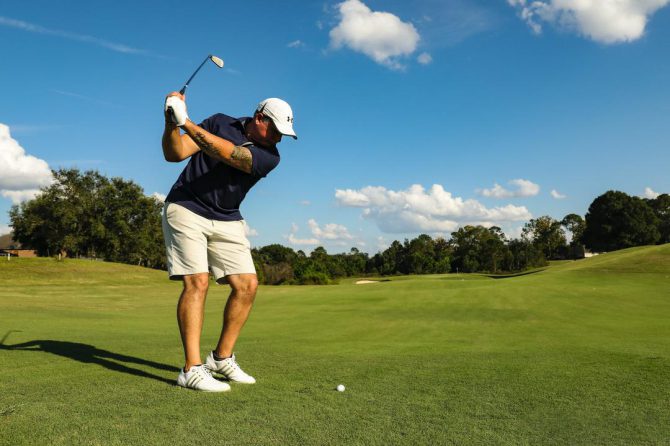Introduction: A Deep Dive into Davis Love III’s Golf Instruction Techniques
Davis Love III is a distinguished figure in professional golf, renowned not only for his impressive record of 20 PGA Tour victories, including the prestigious 1997 PGA Championship but also for his notable contributions to golf instruction. This article aims to thoroughly examine Love’s teaching methods, focusing on the intricate combination of biomechanical principles and cognitive strategies that define his coaching style. By analyzing his distinctive approaches—emphasizing sound swing mechanics and personalized adaptations for golfers of all skill levels—we aim to shed light on how Love empowers aspiring players to elevate their performance. Highlighting both physical and mental aspects of the game, this exploration offers valuable insights for coaches and enthusiasts alike, fostering a deeper understanding of effective instruction as a catalyst for success on the course.
Exploring Swing Mechanics in Davis Love III’s Teaching
Davis Love III’s instructional philosophy strongly emphasizes swing mechanics that are both efficient and adaptable. A cornerstone of his approach is the concept of an expanded swing arc, which enables players to generate ample power while maintaining control over their shots. This technique allows golfers to achieve more consistent contact with the ball, optimizing both distance and accuracy. Key components include:
- Body Alignment: Proper positioning of feet and shoulders in relation to the target.
- Backswing Depth: Advocating for a full yet relaxed backswing that enhances swing speed.
- Follow-through Extension: Emphasizing extension through impact to ensure balance and stability.
Additionally, Love promotes a swing driven by body rotation, rather than relying solely on arm movement. Engaging core muscles during swings helps golfers maintain balance while effectively utilizing their body weight. This method encourages an understanding of how upper and lower body movements interact within swing dynamics. Essential elements include:
- Pivotal Hip Rotation: Initiating power by leading with hip movement during downswing.
- Synchronized Arm Movement: Coordinating arm actions with body rotation for fluidity in swings.
- Weight Transfer: Effectively shifting weight from back foot to front foot throughout the swing.
Beyond physical mechanics, Love integrates vital mental strategies into his teachings, reinforcing how mindset influences performance outcomes. He highlights visualization techniques alongside positive affirmations as crucial tools when preparing for shots—elements that can considerably impact results on the course.
By grasping both mechanical skills and psychological factors involved in golf play, athletes can attain comprehensive mastery over their game through strategic practices such as:
- Pre-shot Routine: Establishing consistent routines fosters focus while promoting relaxation before each shot.
- Mental Rehearsal: Utilizing visualization techniques enhances overall performance during play.
- Adaptability: Encouraging versatility within strategies based upon varying conditions encountered during rounds.
The Importance Of Mental Strategies in Boosting Golf Performance
The incorporation of mental conditioning within golf instruction plays an essential role in achieving peak performance levels out on course grounds; thus emphasizing its necessity becomes paramount according to Davis Love III’s teachings. Techniques aimed at enhancing concentration whilst reducing anxiety prove beneficial when engaging competitively. Visualizing accomplished shots coupled with practicing positive self-talk leads towards improved confidence along heightened focus levels among players alike. Training one’s mind prepares them better against competitive pressures inherent throughout gameplay scenarios faced regularly.
A solid pre-round readiness routine stands central among these teachings; establishing consistent practices involving relaxation exercises like breathing techniques, or mindfulness meditation aids individuals maintain composure throughout rounds played out there! Such emphasis placed upon mental stability allows participants clarity entering games enabling execution without interference stemming from external distractions or internal doubts arising unexpectedly! Many find solidifying this approach yields greater consistency especially under high-stress situations encountered frequently!
Additionally, analytics combined alongside self-assessment serve critical roles enhancing one’s overall mental game! Utilizing various tools & strategies geared towards evaluating oneself helps identify patterns existing within thought processes potentially contributing negatively towards performances observed previously! Metrics such as pressure ratings & decision-making speeds analyzed reveal areas needing improvement further cultivating mindsets focused around continuous learning & adaptation ultimately refining physical skills developed over time whilst building resilience necessary long-term success achieved across sport itself!
Techniques For Fostering Consistency And Adaptability In Play Style!
Davis Love III emphasizes developing consistent setups foundationally important reliable swinging motions executed consistently across varied circumstances faced regularly! Advocating repeatable routines encompassing alignment, grip strength, ball positioning establishes baselines allowing refinement opportunities arise naturally thereafter! Key elements highlighted include:
- Alignment: Ensuring shoulders, hips & feet align parallelly toward target line established beforehand ensures accuracy maintained consistently throughout gameplay sessions engaged actively!
- Grip Pressure: Maintaining firm yet relaxed grips enhances control exerted over clubface ensuring precision remains intact regardless situation presented before player themselves!!
- Ball Position: Adjustments made based upon club selection facilitate optimal angles achieved attacking balls struck effectively!!
The transition from setup into swinging mechanics requires attention paid toward maintaining wide connected arcs present throughout entire motion executed smoothly transitioning backswing downwards seamlessly thereafter!! Drills practiced reinforce concepts facilitating smooth transitions between phases experienced firsthand!! Essential drills recommended comprise:
- One-Arm Swings: Focuses solely on maintaining width using single arms cultivating rhythmic motions developed gradually over time!!
- Slow Motion Swings: Building muscle memory executing slower-paced swings reinforces proper form utilized effectively in later stages!!
- Mirror Drills: Visual feedback utilized ensures correct paths taken along rotations performed accurately observed visually confirming correctness attained successfully!!
Another critical aspect involves incorporating “mental games” into lessons taught; consistency isn’t merely reliant physically alone but also mentally resilient enough to withstand challenges posed regularly encountered on a daily basis too!!! Incorporation visualization exercises routine-building assists students develop stronger frameworks mentally prepared to tackle obstacles head-on confidently moving forward without hesitation whatsoever!!! Key strategies emphasized consist primarily around:
- Mental Resilience: Developing a growth mindset allows players to embrace challenges and view setbacks as opportunities for betterment.
- Visualization Techniques: Consistently practicing visualization strengthens mental focus and confidence.
- Positive Self-Talk: Reinforcing self-belief through encouraging statements enhances mental fortitude.





